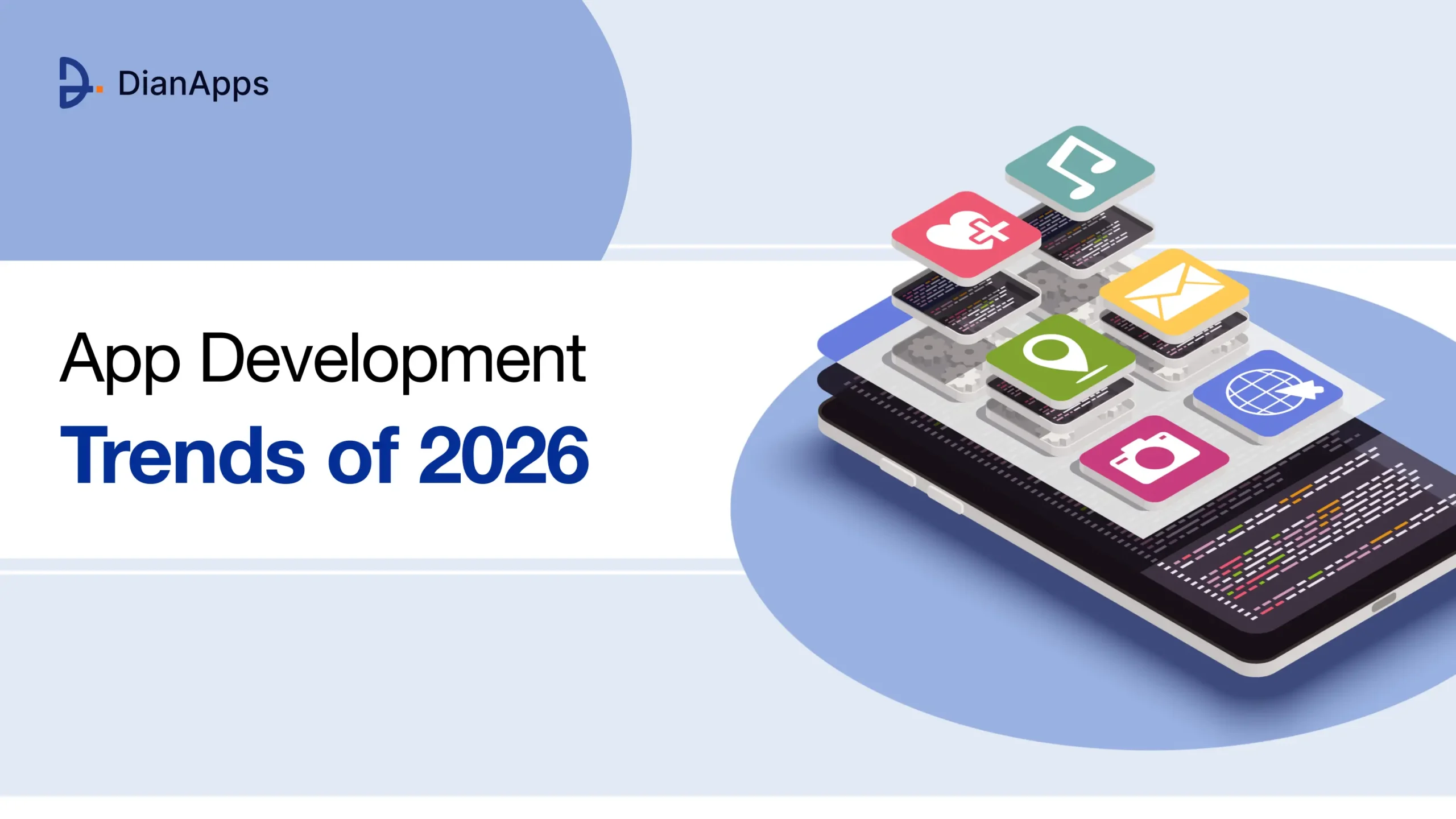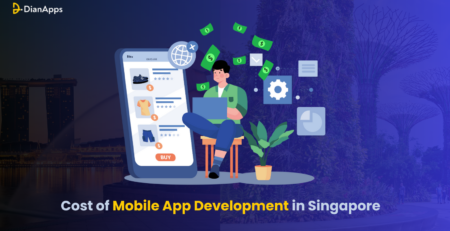Top 10 Mobile App Development Trends in 2026 That Businesses Can’t Ignore
Picture this: You’re scrolling through your phone, and within seconds, an app knows exactly what you need, delivers it faster than you thought possible, and does it all with an interface so intuitive it feels like magic. That’s not science fiction, that’s the reality of mobile app development trends shaping our world right now.
We’re living through one of the most exciting periods in mobile technology. Every day, new possibilities emerge that completely change how we think about what apps can do. However, what’s truly interesting is that the trends we’re seeing in 2026 aren’t just about flashy features or cool tech demos. They’re fundamentally changing how businesses operate and how customers expect to interact with brands.
Think about it this way: five years ago, who would have thought you could point your phone at furniture and see how it looks in your living room? Or that your voice could securely unlock banking apps? These weren’t just wishful thinking; they were glimpses into where mobile app development trends were heading.
Now, if you’re running a business or planning to launch an app, you’re probably wondering which trends actually matter. There’s a lot of noise out there, and frankly, not every shiny new technology is worth your time or money. That’s why working with an experienced mobile app development company becomes crucial, as they can help separate the game-changers from the gimmicks.
But don’t worry, we’re going to cut through all that noise together. Let’s explore the trends that aren’t just making headlines; they’re making real differences in how successful apps are built and how users experience them.
Market Overview of Mobile App Development in 2026
The mobile app development industry has become a global economic powerhouse, with the market reaching $248.86 billion in 2026 and projected to hit $366.84 billion by 2030. This represents a steady 13.4% CAGR, driven by increasing smartphone penetration and evolving user expectations.
Currently, there are over 258.2 billion app downloads worldwide, with users spending an average of 4.8 hours daily on mobile applications. While Android dominates device market share at 70.8%, iOS continues to generate 65% of total app revenue, highlighting the platform’s monetization strength.
According to Grand View Research, the industry supports approximately 6.8 million developers globally, with $47.2 billion in venture capital investment flowing into mobile app startups in 2024 alone. Key growth sectors include FinTech ($47.3 billion), Gaming ($39.8 billion), and E-commerce ($34.7 billion).
Regional markets show diverse opportunities: Asia-Pacific leads with $94.2 billion in market value and the fastest growth rate at 15.8% CAGR, while North America maintains strong revenue per user at $58.33.
1. AI-Powered Mobile Apps: When Your App Actually Gets You
Remember when personalization meant adding your name to an email? Those days are long gone. Today’s AI-powered mobile apps are like having a personal assistant who never sleeps and somehow knows you better than you know yourself.
What makes AI in mobile apps so compelling isn’t just the technology; it’s how it solves real problems. Take Netflix, for example. Their recommendation engine doesn’t just suggest movies; it learns your viewing patterns, considers what time you usually watch, and even factors in what you skipped after watching for just five minutes.
The practical applications are everywhere now. Shopping apps predict when you’ll run out of your favorite products. Fitness apps adjust workout plans based on how you’re actually performing, not just what you said you wanted to do six months ago. Banking apps detect unusual spending patterns and alert you before fraud becomes a real problem.
But here’s what’s really exciting about AI in mobile apps: it’s becoming accessible to businesses of all sizes. You don’t need Google-level resources to implement smart features anymore. Small businesses are using AI chatbots that handle customer service with surprising sophistication, and e-commerce apps are leveraging machine learning to optimize everything from pricing to inventory management.
The numbers tell the story, too. Apps with AI-powered personalization see engagement rates that are consistently 2-3 times higher than their traditional counterparts. Users spend more time in these apps, complete more transactions, and most importantly, they keep coming back.
2. 5G Technology Integration: Finally, The Speed We Were Promised

Let’s be honest, we’ve been hearing about 5G for years, and for a while, it felt more like marketing hype than reality. But 2026 is different. 5G coverage has reached the point where developers can actually build apps that depend on it, and the results are pretty remarkable.
The most obvious benefit is speed, but that’s just the beginning. What 5G really enables is a completely different class of mobile experiences. Cloud gaming is finally viable on mobile devices. You can stream console-quality games without the frustrating lag that made it barely playable before.
Augmented reality applications that used to drain your battery and heat up your phone now run smoothly for hours. Video calls are crystal clear even when you’re walking around, and downloading large files happens so quickly that it almost feels instant.
For businesses, 5G opens up possibilities that weren’t technically feasible before. Real-time collaboration tools work seamlessly even with complex data. IoT applications can handle much larger networks of connected devices. Live streaming and video content delivery reach new levels of quality and reliability.
The interesting thing about 5G integration is that it’s not just about making existing features faster; it’s enabling entirely new categories of apps. We’re seeing applications that would have been impossible just a few years ago, like real-time augmented reality shopping experiences and collaborative virtual workspaces that feel genuinely responsive.
Recommended Read: 5G Technology and Its Impact on Mobile App Development
3. Cross-Platform Development: Smart Business, Better Results
Here’s a question that used to keep business owners up at night: Should we build for iOS first, Android first, or somehow try to do both at the same time? Cross-platform development frameworks have essentially made that question obsolete.
The math is pretty straightforward. Building separate native apps for iOS and Android means double the development time, double the maintenance headaches, and often inconsistent user experiences between platforms. Cross-platform development lets you write your app once and deploy it everywhere, typically saving 40-60% of development costs.
But cost savings are just part of the story. Modern cross-platform frameworks like Flutter and React Native have reached the point where the user experience is virtually indistinguishable from native apps. Users can’t tell the difference, and that’s exactly how it should be.
Flutter, in particular, has gained serious momentum. It’s Google’s framework, and they use it for many of their own apps. The development experience is smooth, the performance is excellent, and the community support is robust. React Native, backed by Meta, offers the advantage of leveraging existing React knowledge, making it easier for web developers to transition to mobile development.
What’s really compelling about cross-platform development is how it affects time-to-market. Instead of launching on one platform and then spending months porting to others, you can launch simultaneously everywhere. In competitive markets, that timing advantage can be the difference between success and playing catch-up.
4. Progressive Web Apps (PWAs): Rethinking the App Store Model
Progressive Web Apps are quietly revolutionizing mobile experiences, and many users don’t even realize they’re not using traditional native apps. PWAs run in web browsers but feel and behave like native apps, complete with offline functionality, push notifications, and home screen installation.
The business case for PWAs is compelling. Development costs are typically 50-70% lower than native apps, and you completely bypass app store approval processes and fees. Users can start using your app instantly without downloads, which dramatically improves conversion rates.
Twitter Lite is one of the most successful PWA examples. It loads in under three seconds on slow networks, uses 70% less data than the native app, and increases user engagement by 65%. Pinterest saw similar results with their PWA, experiencing 44% more user-generated ad revenue and 60% more core engagements.
The technology behind PWAs has matured significantly. Service workers enable robust offline functionality, web app manifests provide native-like installation experiences, and modern browsers support most of the device APIs that native apps rely on.
For businesses, PWAs offer a unique advantage: you can test your app concept quickly and cost-effectively before committing to full native development. Many companies start with a PWA and then decide whether native features justify the additional investment.
5. Augmented Reality and Virtual Reality: Beyond Gaming

AR and VR have finally moved beyond the “cool demo” phase into practical, everyday applications. The technology has matured to the point where it solves real problems for real users, not just tech enthusiasts.
In retail, AR has become a game-changer. IKEA’s app lets you place furniture in your room before buying. Sephora’s virtual try-on feature helps customers test makeup shades. These aren’t gimmicks; they’re solving the fundamental challenge of online shopping: uncertainty about how products will work in your real environment.
The healthcare applications are equally impressive. Medical students use VR for surgical training. Patients use AR apps to better understand their treatment plans through 3D visualization. Physical therapy apps guide patients through exercises with real-time feedback.
Real estate has embraced VR for virtual tours, especially after the pandemic made in-person visits complicated. Buyers can walk through properties from anywhere, and sellers can showcase homes to a global audience without the logistics of physical showings.
What’s made AR/VR practical for mainstream adoption is the improvement in smartphone cameras and processors. Most AR experiences now work well on standard smartphones without requiring specialized hardware. The barrier to entry has dropped dramatically.
6. IoT-Enabled Mobile Apps: Your Phone as Mission Control
The Internet of Things has created an ecosystem where your smartphone becomes the central hub for managing your connected world. Smart homes, fitness trackers, industrial sensors, and connected cars all rely on mobile apps as their primary interface.
Smart home integration showcases IoT’s potential perfectly. Your phone can control lighting, security systems, thermostats, and appliances. But it goes beyond simple remote control; these systems learn your patterns and automate routine tasks. Your home can adjust temperature based on when you typically arrive from work, or turn off forgotten lights when you leave.
In healthcare, IoT-enabled apps connect with wearable devices to provide continuous health monitoring. They track everything from heart rate and sleep patterns to blood glucose levels, alerting both users and healthcare providers to potential issues before they become serious problems.
Industrial applications are equally compelling. Manufacturing companies use mobile apps to monitor equipment performance, predict maintenance needs, and optimize production schedules. Workers can access real-time data about machinery status and receive alerts about potential problems.
The key to successful IoT integration is making complex systems feel simple to users. The best IoT apps hide the technical complexity behind intuitive interfaces that let users focus on outcomes rather than technical details.
7. Blockchain Integration: Trust and Security Redefined
Blockchain technology in mobile apps goes far beyond cryptocurrency, though that’s certainly one important application. At its core, blockchain provides a way to create trust and transparency in digital transactions without requiring a central authority.
Financial apps are the most obvious beneficiaries. Blockchain enables secure, transparent transactions that users can verify independently. It’s particularly valuable for international transfers, where traditional banking systems are slow and expensive. Users can send money across borders in minutes rather than days, with full transparency about fees and exchange rates.
Supply chain applications demonstrate blockchain’s broader potential. Apps can track products from manufacturing through delivery, providing consumers with verified information about origin, quality, and handling. This is particularly valuable for industries where authenticity matters, like luxury goods, pharmaceuticals, and organic food.
Identity verification is another promising application. Blockchain-based identity systems give users control over their personal information while providing apps with verified, tamper-proof identity data. This reduces fraud while protecting user privacy.
The challenge with blockchain integration is balancing security and usability. The most successful implementations hide the technical complexity behind simple, familiar interfaces while providing the transparency and security benefits that make blockchain valuable.
Recommended Read: How Blockchain Enhances Mobile App Security
8. Voice Search and Voice-Enabled Interfaces: Conversation as Interface
Voice interaction has evolved from a novelty feature to an expected capability. Users increasingly expect to be able to search, navigate, and control apps using natural speech, especially when their hands are busy or screens are inconvenient.
Voice search has become particularly important for content discovery. Users can find information, products, and services using conversational queries rather than trying to guess the right keywords. This is especially valuable for mobile users who might be walking, driving, or multitasking.
Voice commands for app navigation improve accessibility and convenience. Users can control music playback, set reminders, send messages, and perform routine tasks without touching their screens. This hands-free capability is essential for safety in situations like driving or exercising.
The technology has reached the point where voice interfaces can handle complex, multi-step interactions. Banking apps let users check balances, transfer money, and pay bills using voice commands. Shopping apps can handle product searches, order placements, and delivery tracking through natural conversation.
What makes voice interfaces successful is designing for how people actually talk, not how they type. The best voice-enabled apps understand context, handle follow-up questions, and provide clear verbal feedback about what’s happening.
9. Mobile Commerce Evolution: Shopping Reimagined
Mobile commerce has evolved far beyond simple mobile-friendly websites. Today’s mobile shopping experiences integrate social media, augmented reality, artificial intelligence, and streamlined payment systems to create seamless purchase journeys.
Social commerce represents one of the most significant shifts. Users discover products through social media feeds, research them through user-generated content, and complete purchases without leaving their favorite social platforms. Instagram, TikTok, and Pinterest have all integrated shopping features that feel natural within their existing user experiences.
One-click purchasing has become standard, but the best mobile commerce apps go even further. They remember user preferences, predict likely purchases, and proactively suggest relevant products. Amazon’s “Buy Again” feature exemplifies this approach, making it effortless to reorder consumable products.
Augmented reality is transforming how users evaluate products before purchasing. Fashion apps let users virtually try on clothes. Furniture apps show how pieces look in their homes. Cosmetics apps provide realistic makeup try-on experiences. These features reduce returns and increase customer satisfaction.
Payment integration has become frictionless. Mobile wallets, biometric authentication, and saved payment methods mean users can complete purchases in seconds rather than minutes. The best mobile commerce experiences make buying feel effortless.
10. On-Demand Apps: Instant Everything
The on-demand economy has expanded far beyond ride-sharing and food delivery. Consumers now expect instant access to virtually every service, and mobile apps are the delivery mechanism that makes this possible.
Healthcare on-demand has gained significant traction. Telemedicine apps connect patients with doctors for consultations, prescription renewals, and follow-up care. Mental health apps provide immediate access to counselors and therapy sessions. These services became essential during the pandemic and have remained popular due to their convenience and accessibility.
Professional services have embraced the on-demand model. Legal advice, financial planning, tutoring, and consulting services are now available through mobile apps with same-day or even immediate availability. Users can get expert help when they need it rather than scheduling appointments weeks in advance.
Home services represent another growing category. Apps for cleaning, repairs, maintenance, and installation services let users book qualified professionals with transparent pricing and scheduling. Reviews and ratings systems provide confidence in service quality.
The success of on-demand apps depends on balancing speed with quality. Users want immediate access, but they also expect reliable, professional service. The best on-demand apps invest heavily in vetting service providers and maintaining quality standards.
How a Company Like DianApps Ensures Following These Trends
An expert Android or iOS app development company like DianApps stays ahead by implementing strategic approaches to trend adoption and client success.
Continuous Technology Research
Development teams dedicate significant time to evaluating emerging technologies, attending industry conferences, and participating in developer communities. This ensures they understand not just what’s technically possible, but what’s practical for real-world applications.
Investment in Team Development
Regular training programs keep developers current with new frameworks, tools, and best practices. Certification in emerging technologies like AR development, blockchain integration, and AI implementation ensures teams can deliver cutting-edge solutions.
Prototyping and Testing
Before recommending trends to clients, experienced companies build internal prototypes to understand implementation challenges, performance implications, and user experience considerations. This hands-on experience informs realistic project planning and expectation setting.
Client Education and Strategy
Rather than simply implementing whatever clients request, leading companies provide strategic guidance about which trends align with business objectives. They analyze target audiences, competitive landscapes, and technical requirements to recommend the most effective approach.
Agile Implementation
Flexible development methodologies allow for iterative trend integration. Teams can test new technologies in controlled environments before full implementation, reducing risk while maintaining innovation momentum.
In this section, you must have completely understood how an app development company ensures the implementation of all the latest trends. If you need more detailed information, make sure to learn from a detailed guide to the mobile app development process.
Key Takeaways for Business Success
The mobile app landscape continues evolving rapidly, but successful businesses focus on trends that solve real problems for their users. Rather than chasing every new technology, smart companies evaluate trends based on their potential impact on user experience and business objectives.
Cost-effectiveness matters as much as innovation. The most successful trend implementations provide clear return on investment through improved user engagement, operational efficiency, or revenue generation. Cross-platform development and PWAs often provide the best balance of innovation and practicality for many businesses.
User experience should drive technology choices, not the other way around. The best apps seamlessly integrate trending technologies in ways that feel natural and valuable to users. When technology implementation is invisible to users but improves their experience, that’s when trends become truly successful.
Partnership with experienced development teams becomes crucial as technology complexity increases. The companies that successfully navigate these trends work with development partners who understand both the technical possibilities and the practical business considerations that determine success.
Final Words
The mobile app development landscape in 2026 offers unprecedented opportunities for businesses willing to embrace change and innovation. These trends aren’t just technological curiosities; they represent fundamental shifts in how users expect to interact with mobile applications.
Success comes from thoughtful implementation rather than blind adoption. The businesses that thrive will be those that carefully evaluate which trends align with their goals, provide genuine value to their users, and can be implemented effectively within their resources and timelines.
The mobile revolution shows no signs of slowing down. New possibilities emerge constantly, user expectations continue rising, and competitive advantages go to companies that can adapt quickly and effectively. The trends we’ve explored provide a roadmap for navigating this dynamic landscape.
Remember that technology serves users, not the other way around. The most successful apps seamlessly integrate these trending technologies in ways that solve real problems, improve daily experiences, and provide clear value. When users stop noticing the technology because it works so naturally, that’s when you know you’ve succeeded.
The future belongs to businesses that can balance innovation with practicality, staying ahead of trends while remaining focused on what matters most: creating apps that users genuinely love and find valuable in their daily lives.




